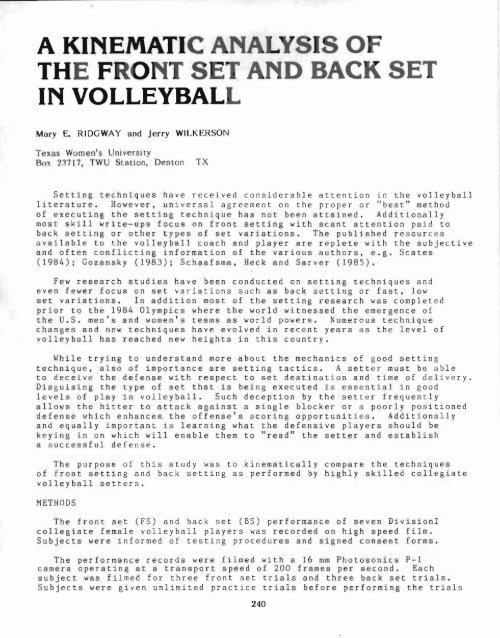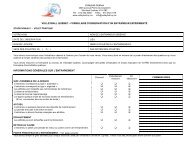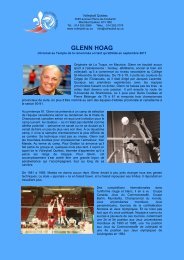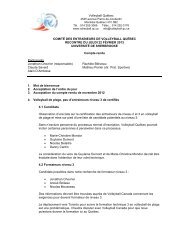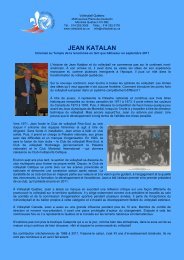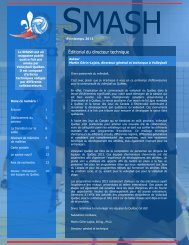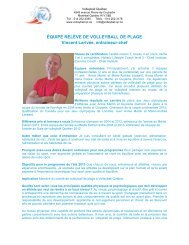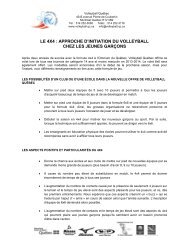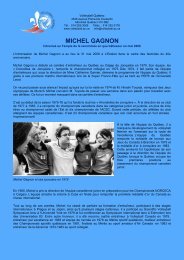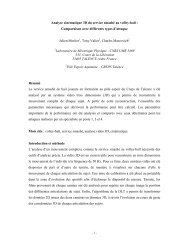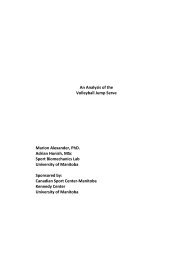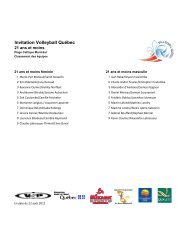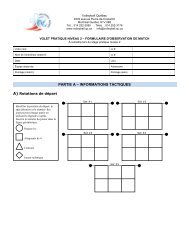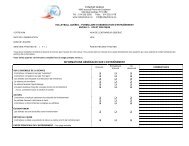a kinematic analysis 0 the front set and bac set in volleyball
a kinematic analysis 0 the front set and bac set in volleyball
a kinematic analysis 0 the front set and bac set in volleyball
- No tags were found...
Create successful ePaper yourself
Turn your PDF publications into a flip-book with our unique Google optimized e-Paper software.
A KINEMATIC ANALYSIS 0THE FRONT SET AND BACIN VOLLEYBALLSETMary E. RIDGWAY <strong>and</strong> Jerry WILKERSONTexas Women's UniversityBox 2.1717, TWU Station, DentonTXSett<strong>in</strong>g techniques have received considerable attention <strong>in</strong> <strong>the</strong> <strong>volleyball</strong>literature. However, universal agreement on <strong>the</strong> proper or "best" methodof execut<strong>in</strong>g <strong>the</strong> <strong>set</strong>t<strong>in</strong>g technique has not been atta<strong>in</strong>ed. Additionallymost skill write-ups focus on <strong>front</strong> <strong>set</strong>t<strong>in</strong>g with scant attention paid to<strong>bac</strong>k <strong>set</strong>t<strong>in</strong>g or o<strong>the</strong>r types of <strong>set</strong> variations. The published resourcesvailable to <strong>the</strong> <strong>volleyball</strong> coach <strong>and</strong> player are replete with <strong>the</strong> subjective<strong>and</strong> often conflict<strong>in</strong>g <strong>in</strong>formation of <strong>the</strong> various authors, e.g. Scates(1984); Gozansky (1983); Schaafsma, Heck <strong>and</strong> Sarver (1985).Few research studies have been conducted on <strong>set</strong>t<strong>in</strong>g techniques <strong>and</strong>even fewer focus on <strong>set</strong> variations such as <strong>bac</strong>k <strong>set</strong>t<strong>in</strong>g or fast, low<strong>set</strong> variations. In addition most of <strong>the</strong> <strong>set</strong>t<strong>in</strong>g research was completedprior to <strong>the</strong> 1984 Olympics where <strong>the</strong> world witnessed <strong>the</strong> emergence of<strong>the</strong> U.S. men's <strong>and</strong> women's teams as world powers. Numerous techniquechanges <strong>and</strong> new techniques have evolved <strong>in</strong> recent years as <strong>the</strong> level of<strong>volleyball</strong> has reached new heights <strong>in</strong> this country.While try<strong>in</strong>g to underst<strong>and</strong> more about <strong>the</strong> mechanics of good <strong>set</strong>t<strong>in</strong>gtechnique, also of importance are <strong>set</strong>t<strong>in</strong>g tactics. A <strong>set</strong>ter must be ableto deceive <strong>the</strong> defense with respect to <strong>set</strong> dest<strong>in</strong>ation <strong>and</strong> time of delivery.Disguis<strong>in</strong>g <strong>the</strong> type of <strong>set</strong> that is be<strong>in</strong>g executed is essential <strong>in</strong> goodlevels of play <strong>in</strong> <strong>volleyball</strong>. Such deception by <strong>the</strong> <strong>set</strong>ter frequentlyallows <strong>the</strong> hitter to attack aga<strong>in</strong>st a s<strong>in</strong>gle blocker or a poorly positioneddefense which enhances <strong>the</strong> offense's scor<strong>in</strong>g opportunities. Additionally<strong>and</strong> equally important is learn<strong>in</strong>g what <strong>the</strong> defensive players should bekey<strong>in</strong>g <strong>in</strong> on which will enable <strong>the</strong>m to "read" <strong>the</strong> <strong>set</strong>ter <strong>and</strong> establisha successful defense.The purpose of this study was to <strong>k<strong>in</strong>ematic</strong>ally compare <strong>the</strong> techniquesof <strong>front</strong> <strong>set</strong>t<strong>in</strong>g <strong>and</strong> <strong>bac</strong>k <strong>set</strong>t<strong>in</strong>g as performed by highly skilled collegiate<strong>volleyball</strong> <strong>set</strong>ters.METHODSThe <strong>front</strong> <strong>set</strong> (FS) <strong>and</strong> <strong>bac</strong>k <strong>set</strong> (BS) performance of seven DivisionIcollegiate female <strong>volleyball</strong> players was recorded on high speed film.Subjects were <strong>in</strong>formed of test<strong>in</strong>g procedures <strong>and</strong> signed consent forms.The performance records were filmed with a 16 mm Photosonics P-1camera operat<strong>in</strong>g at a transport speed of 200 frames per second. Eachsubject was filmed for three <strong>front</strong> <strong>set</strong> trials <strong>and</strong> three <strong>bac</strong>k <strong>set</strong> trials.Subjects were given unlimited practice trials before perform<strong>in</strong>g <strong>the</strong> trials240
used for film<strong>in</strong>g. The camera was located 9.44 m from <strong>the</strong> sagittal viewof each subject. A <strong>volleyball</strong> tra<strong>in</strong><strong>in</strong>g device, "Catch-It, Bask-It", <strong>set</strong>5.46 m from <strong>the</strong> subject was used to provide a vertical <strong>and</strong> horizontal<strong>set</strong>t<strong>in</strong>g arget for <strong>the</strong> subjects. All data were collected outdoors on atennis court <strong>in</strong> natural light<strong>in</strong>g.Spatial coord<strong>in</strong>ates were obta<strong>in</strong>ed through <strong>the</strong> utilization,of a Sonicdigitizer <strong>in</strong>terfaced with an Apple lIe microcomputer. N<strong>in</strong>eteen segmentalend po<strong>in</strong>ts from alternate frames were analyzed by software written byRichards <strong>and</strong> Wilkerson (1984). Digitiz<strong>in</strong>g of each trial began with <strong>the</strong>po<strong>in</strong>t of maximum fl xion def<strong>in</strong><strong>in</strong>g <strong>the</strong> conclusion of <strong>the</strong> preparation phase<strong>and</strong> cont<strong>in</strong>ued until ball release. The raw data were smoo<strong>the</strong>d with a secondorder low pass digital filter <strong>set</strong> at 6 Hz.K<strong>in</strong>ematic variables for <strong>the</strong> biomechanical <strong>analysis</strong> of <strong>the</strong> ball werederived from geometric center of <strong>the</strong> ball as def<strong>in</strong>ed by Hudson (1982).Three ball spatial coord<strong>in</strong>ates that shared no common X or Y coord<strong>in</strong>ateswere submitted to <strong>the</strong> triangulation method by Hudson (1982) for X <strong>and</strong> Ycoord<strong>in</strong>ate dcterm<strong>in</strong>ation of <strong>the</strong> geometric center. Ball center coord<strong>in</strong>ateswere stored <strong>and</strong> fur<strong>the</strong>r analyzed <strong>k<strong>in</strong>ematic</strong>ally.Body position which were represented by angles were selected for <strong>analysis</strong>for <strong>the</strong> purpose of del<strong>in</strong>eat<strong>in</strong>g <strong>and</strong> compar<strong>in</strong>g <strong>the</strong> two <strong>volleyball</strong> <strong>set</strong>t<strong>in</strong>gtechniques. Specific angular <strong>k<strong>in</strong>ematic</strong>s were analyzed. The wrist, elbow,knee, <strong>and</strong> ankLe angles were def<strong>in</strong>ed by l<strong>in</strong>es drawn between <strong>the</strong> articulationof <strong>in</strong>terest ~nd <strong>the</strong> adjacent jo<strong>in</strong>ts. Additional angles of <strong>in</strong>cl<strong>in</strong>ation ofbody segments were analyzed. The shoulder angle of <strong>in</strong>cl<strong>in</strong>ation was def<strong>in</strong>ed asmotion around <strong>the</strong> shoulder articulation formed by a l<strong>in</strong>e through <strong>the</strong> upperarm segment relative to <strong>the</strong> vertical. The angles of <strong>in</strong>cl<strong>in</strong>ation of <strong>the</strong>trunk, head, <strong>and</strong> thigh were measured relative to <strong>the</strong> horizontal around<strong>the</strong>Ir respective articulations.The temporal <strong>and</strong> ball variables analyzed were velocity of ball at release,angle of ball projection, time of ball contact, <strong>and</strong> distance of ball from<strong>the</strong> forehead at <strong>in</strong>itial ball contact. Temporal <strong>analysis</strong> of ball contactwas subdivIded <strong>in</strong>to absorption phase <strong>and</strong> propulsion phase. The absorptionphase was def<strong>in</strong>ed as from <strong>the</strong> moment of <strong>in</strong>itial contact until slow<strong>in</strong>g of<strong>the</strong> ball had ceased; <strong>and</strong> propulsion phase occurred from <strong>the</strong> end of absorptionuntil ball release.RESULTSJo<strong>in</strong>t K<strong>in</strong>ematicsMany similarities exist between <strong>the</strong> FS <strong>and</strong> BS with respect to <strong>the</strong>use of <strong>the</strong> various jo<strong>in</strong>ts studied. Differences were observed between<strong>the</strong> shoulders, head, <strong>and</strong> trunk <strong>in</strong> execut<strong>in</strong>g <strong>the</strong> two types of <strong>set</strong>s. Table1represents angular positions dur<strong>in</strong>g <strong>the</strong> follow<strong>in</strong>g phases of <strong>the</strong> <strong>set</strong>:1) start (S) of body movement toward <strong>the</strong> ball" 2) at <strong>in</strong>itial ball contact(C), <strong>and</strong> 3) time of ball release (R). The head was positioned at 73.42deg (FS-S) <strong>and</strong> 64.82 deg (BS-S). At release <strong>the</strong> head had moved a negligibleamount <strong>in</strong> <strong>the</strong> FS (74.9 deg) while hyperextend<strong>in</strong>g to 40.03 deg <strong>in</strong> <strong>the</strong> BS.Similar patterns of movement occurred <strong>in</strong> <strong>the</strong> trunk. The trunk was positionedat 101.86 deg (FS-S) <strong>and</strong> 96.45 deg (BS-S). By <strong>the</strong> time of ball release<strong>the</strong> trunk had moved to a vertical position for <strong>the</strong> FS (90.60 deg) <strong>and</strong> to ahyperextended position for <strong>the</strong> BS (74.77 deg). Shoulder angles varied from112.22 deg (FS-S) to 50.45 deg (FS-R). For he BS jo<strong>in</strong>t angles variedconsiderably from 106.14 deg (BS-S) to 23.22 deg (BS-R) <strong>in</strong>dicat<strong>in</strong>g a greaterrange of motion (ROM) <strong>in</strong> <strong>the</strong> shoulder jo<strong>in</strong>t dur<strong>in</strong>g <strong>the</strong> BS.241
TABLE 1JOINT KINEMATICSJOINT SET !:I.-Start SD !:I.-Contact SD !:I.-Release SD11 "d dFS 73.42 a 10.75 71.96 10.75 74.90 14.01BS 64.82 8.84 51. 32 4.83 40.03 9.15Trunk FS 101.86 4.17 92.32 7.10 90.60 8.32BS 96.45 6.57 81.22 6.54 74.77 6.99Shoulder FS 1 12 . 22 29.43 69.27 21.33 50.45 16.948S 106.14 31.40 57.40 14.90 23.22 15.09ElbowFS 101.07 11.03 141.56 16.39 159.60 11.598S 102.24 19.17 132.06 8.85 153.30 11.23WristFS 151.04 11.23 126.41 10.28 137.89 9.42BS 144.08 12.34 130.47 8.74 143.23 8.73lIipFS 53.13 10.60 72.27 13.67 80.47 13.238S 54.77 12.09 72.94 10.79 84.19 10.99KneeFS 114.80 13.82 138.33 16.97 150.51 15.638S 114.06 11.25 134. 17 10.41 155.40 11. 01Ankle FS 102.66 11.69 126.23 21. 81 134.38 20.23BS 108.64 9.48 119.32 14.99 131.92 16.80a~leanvalues <strong>in</strong> degr~es.At <strong>the</strong> on<strong>set</strong> of ball contact jo<strong>in</strong>t extension had occurred <strong>in</strong> 311 jo<strong>in</strong>ts,both for <strong>the</strong> FS <strong>and</strong> BS with <strong>the</strong> exception of <strong>the</strong> wrist. Most subjects hadseveral changesof direction <strong>in</strong> wrist/h<strong>and</strong> movement dur<strong>in</strong>g <strong>set</strong>t<strong>in</strong>g. Severalsubjects flexed <strong>the</strong> wrist prior to contact, hyperextended <strong>the</strong> wrist dur<strong>in</strong>g<strong>the</strong> ball absorption phase <strong>and</strong> <strong>the</strong>n flexed aga<strong>in</strong> dur<strong>in</strong>g <strong>the</strong> propulsion phase.It appears that <strong>the</strong> wrists are not held firm dur<strong>in</strong>g <strong>set</strong>t<strong>in</strong>g.A summary of <strong>the</strong> range of motion of <strong>the</strong> different jo<strong>in</strong>ts is presented<strong>in</strong> Table 2. In study<strong>in</strong>g <strong>the</strong> ROM experienced by <strong>the</strong> different body segments,<strong>the</strong> head position varied from a mean range of 2 deg (FS) to 24 deg (BS).Similarly <strong>the</strong> trunk positions were observably different with <strong>the</strong> trunkmov<strong>in</strong>g through a range of 11 deg for <strong>the</strong> FS <strong>and</strong> 21 deg for <strong>the</strong> BS. ShoulderROM differed from 62 deg (FS) to 83 deg (BS). In establish<strong>in</strong>g a hierarchyfor <strong>the</strong> jo<strong>in</strong>t ROM's <strong>the</strong> three most active jo<strong>in</strong>ts for both types of <strong>set</strong>s,<strong>in</strong> order, were <strong>the</strong> shoulder, elbow, <strong>and</strong> knee.Position/time data (Figures 1-4) analyzed from <strong>the</strong> start of <strong>the</strong> <strong>set</strong> torelease of <strong>the</strong> ball revealed two prevalent patterns <strong>in</strong> <strong>the</strong> temporal sequenceof movement of <strong>the</strong> shoulder, elbow, hip, <strong>and</strong> knee. In 8 of 14 trialsanalyzpd <strong>the</strong> elbows began extend<strong>in</strong>g prior to <strong>the</strong> knees. In Figures 1 <strong>and</strong> 2position/time data for Ss 1 execut<strong>in</strong>g a FS <strong>and</strong> Ss3 execut<strong>in</strong>g a BS aredisplayed. Both subjects' patterns demonstrated a pattern of <strong>the</strong> elbows<strong>in</strong>itiat<strong>in</strong>g extension prior to <strong>the</strong> knees. Additionally <strong>the</strong>re are observablesimilarities between <strong>the</strong> jo<strong>in</strong>t movements <strong>and</strong> <strong>the</strong> temporal sequenc<strong>in</strong>g for<strong>the</strong> FS <strong>and</strong> BS. In <strong>the</strong> rema<strong>in</strong><strong>in</strong>g six trials studied <strong>the</strong> subiects began knee<strong>and</strong> elbow extension at approximately <strong>the</strong> same time. Figures 3 <strong>and</strong> 4 arerepresentative of such a temporal movement pattern occurr<strong>in</strong>g dur<strong>in</strong>g Ss 3'sFS <strong>and</strong> Ss l's BS. Aga<strong>in</strong> similarities are apparent between <strong>the</strong> FS <strong>and</strong> BSwith respect to position/time data of <strong>the</strong> shoulder, elbow, hip, <strong>and</strong> knee.242
TABLE 2JOINT RANGE OF ~lOTIONSUMMARYJo<strong>in</strong>t Front Seta Rank Back Set RankHead 2 8 24 5Trunk 11 7 21 7.';houlder 62 I 83 I1':1 bow 59 2 51 2Wrist 13 6 13 8Hip 27 5 29 4K01';' 37 3 41 3Ankl~ 31 4 23 6Ball K<strong>in</strong>ematicsBMean range values <strong>in</strong> degrees.Ball <strong>k<strong>in</strong>ematic</strong> data are <strong>in</strong>cluded <strong>in</strong> Table 3. The total time of ballcontact was slightly longer <strong>in</strong> <strong>the</strong> BS than <strong>in</strong> <strong>the</strong> FS. In study<strong>in</strong>g <strong>the</strong>absorption <strong>and</strong> propulsion phases it may be noted that more time was spent<strong>in</strong> <strong>the</strong> propulsion phase than <strong>in</strong> <strong>the</strong> absorption phase. Time for ballpropulsion was slightly longer for <strong>the</strong> BS (BS-P=.061s) than for <strong>the</strong> FS(fS-P=.49s). Both k<strong>in</strong>ds of <strong>set</strong>s resulted <strong>in</strong> similar projection velocities(FS-8.96 m/s; BS-9.09 m/s). Projection angles differed as expected whenconsider<strong>in</strong>g <strong>the</strong> difference <strong>in</strong> <strong>set</strong> dest<strong>in</strong>ation. A mean projection angleof 62.01 deg for <strong>the</strong> FS <strong>and</strong> 108.73 deg for <strong>the</strong> BS resulted. Distance of<strong>the</strong> center of <strong>the</strong> ball to <strong>the</strong> forehead at contact was 33.77 cm (FS) <strong>and</strong>34.47 cm.'Ji\BLE JBALL KINU1ATICSVARIABLE SET klSOAbsorpti.onTime (scc)FS .024 2.26E-05BS .025 5.00E- 03PropulsionTime (sec)FS .049 9.45E- 03BS .061 .01Total time (sec)FS .072 .01BS .086 .01Release Velocity(m/s)FS 8.96 2.18BS 9.09 I. 79Angle of Projection(d g)FS 62.01 5.04IlS 108.7J 9.07Distance of Ballto Forehead (cm)FS 33.77 4.38BS 34 .47 6 .59243
Position (deg)160 1 .... •,·7160 r7.-.-.-.-•. !>••••- 0/140 .... .f>/• .r p..p120 ~:o~.;:o-./o -0..1>-0'... - -0-0I .- .' .,100.. .' \j-0-0 - 0... o~o60 ,......0'.'...0,0'60 -000-0,0r-o-o_o~~~- ~~40 -.'.'.20 ~-._..•- ShOUlder·0- Knee.•- Elbow·0- Hipo I I I I I I I I I I I I I I I I I I I1 3 5 7 9 1 1 1 1 13 5 7 9Time (1 unit = .025)Figure 1.Position/time data forSs l's FS160~ j_. ., 0_0-0140 -., • 0;120 '-. /0 _.-....•....... ...0 ....;- .....0-0 .;0 .;100 t _o_o_o_o_o~!~r:::il"'·;60 t-·-·-·-·... 'Position (deg) 1- - - - - -0- -o-o~_o-O-O-O-O0 0 0 060 + 0 0 '...- Shoulder·0- Hip.•- Elbow·0- Knee40 + '\'--.~20o I I I I I I I I I I I I I I I I12345676910111213141516Time (1 unit = .025)Figure 2.Position/time data for Ss3's BS244
:::I140 _.-.- C-o_t--..-._.__ • -- 0-.--_.---·0120 >.......... _0................. _--0• .- ........ 0-....100 Cl-O-O-O-c-o~ +-.__Position (deg)._- Shoulder80 j -·_~o:::::o_o-oo.--D-0::r-0---0 -__- __·0- Hip60 0_ 0 _ 0 .•- Elbow·0- Kneeo2 3 4 567 8 9 10 11 12 13 14 15Time (1 unit .025)Figure 3.Position/time data for Ss 3's FS180 f 0_0 _ 00 ...............•160 0:::;:"'"o_o?140 [J-o 0 [J o_o-o-.~I - - - .-.120 _.-----.-.-.'0- ShoulderPosition (deg) lOO! .-.-. _._. .•- Hip80 0-0-0-0 .-.I -0_- .·0- Elbow60 .j. _._.-.-.-.-0.........::1.-.~~\~'o1 2 3 4 5 6 7 8 9 10 11 12 13 14Time (1 unit = .02s)Figure 4.Position/time data for Ss l's BSDISCUSSION ANDCONCLUSIONSWith<strong>in</strong> <strong>the</strong> limitations of this study, it was concluded that <strong>the</strong>similarities between <strong>set</strong>ters when execut<strong>in</strong>g a FS or BS exceed any differencesobserved. While realiz<strong>in</strong>g <strong>the</strong>re is rarely one form that is ideal forevery performer, many observations may be made regard<strong>in</strong>g <strong>set</strong>t<strong>in</strong>g techniqueof <strong>the</strong> subjects analyzed <strong>in</strong> this study. From <strong>the</strong>se results <strong>the</strong> critical<strong>k<strong>in</strong>ematic</strong> patterns that may dictate success <strong>in</strong> <strong>set</strong>t<strong>in</strong>g have begun to beidentified.245
In study<strong>in</strong>g body segment movements dur<strong>in</strong>g <strong>the</strong> two types of <strong>set</strong>s, <strong>the</strong>head, trunk, <strong>and</strong> shoulder exhibited <strong>the</strong> greatest posit~onal variuncebetween <strong>the</strong> PS <strong>and</strong> BS. Greater angular displacement occurred dur<strong>in</strong>g BSexecution. This was not unexpected when consider<strong>in</strong>g <strong>the</strong> task of project<strong>in</strong>ga ball overhead <strong>in</strong> a <strong>bac</strong>kward direction.The more vertical position of <strong>the</strong> head <strong>and</strong> tr~nk at <strong>the</strong> start of <strong>the</strong><strong>bac</strong>k <strong>set</strong> may provide critical positionsl cues for <strong>the</strong> defense <strong>in</strong> anticipat<strong>in</strong>g<strong>set</strong> dest<strong>in</strong>ation. Also, <strong>the</strong> greater hyperextension movements Wllich wereexperienced by <strong>the</strong> head <strong>and</strong> trunk dur<strong>in</strong>g <strong>the</strong> BS may be discernihle hydefensive players. Such <strong>in</strong>formation could result <strong>in</strong> allow<strong>in</strong>g <strong>the</strong> defen<strong>set</strong>ime to make defensive adjustments prior to <strong>the</strong> attack.From an offensive st<strong>and</strong>po<strong>in</strong>t <strong>the</strong> <strong>set</strong>ter should attempt to m<strong>in</strong>imizebody position Jifferences <strong>in</strong> execut1ng tbe two types of <strong>set</strong>s, or at <strong>the</strong>very least <strong>the</strong>y should attempt to delay as long as possible, position<strong>in</strong>g<strong>the</strong> body <strong>in</strong> an "obvious" <strong>bac</strong>k <strong>set</strong>t<strong>in</strong>g posture.The <strong>set</strong>ters <strong>in</strong> this study varied to some extent <strong>in</strong> <strong>the</strong>ir <strong>set</strong>t<strong>in</strong>gtechnique <strong>in</strong> comparison to what has been reported <strong>in</strong> some of <strong>the</strong> <strong>volleyball</strong>literature. An often reported statement (Scates 1985) regard<strong>in</strong>g tileposition of <strong>the</strong> ball <strong>in</strong> relation to <strong>the</strong> head is to contact <strong>the</strong> ball six<strong>in</strong>ches <strong>in</strong> <strong>front</strong> of <strong>the</strong> face. The mean distances (hall-ta-forehead) wereapproximately 13.3 <strong>in</strong>ches (FS) <strong>and</strong> 13.6 <strong>in</strong>ches (8S). Even allow<strong>in</strong>g forme8surRment to <strong>the</strong> edge of <strong>the</strong> ball <strong>in</strong>stead of <strong>the</strong> geometric center doesnot account for such a discrepancy. Ridgway, Hay, & Gench (1985) reported<strong>in</strong> a recent <strong>set</strong>t<strong>in</strong>g study a mean distance of 13 <strong>in</strong>ches for <strong>the</strong> FS. Apossible explanation of <strong>the</strong> conflict<strong>in</strong>g reports is that <strong>the</strong> <strong>set</strong>ters analyzed<strong>in</strong> this <strong>in</strong>vestigation <strong>in</strong>itiated movement toward <strong>the</strong> ball well before contact.Schaafsma, Heck, & Sarver (1985) state that little extension beg<strong>in</strong>sprior to contact <strong>and</strong> only <strong>in</strong> <strong>the</strong> legs, with <strong>the</strong> elbows not beg<strong>in</strong>n<strong>in</strong>gextension until contact with <strong>the</strong> ball. Such technique would result <strong>in</strong>a closer contact po<strong>in</strong>t relative to <strong>the</strong> forehead, <strong>and</strong> <strong>the</strong>se authors recommenda contact po<strong>in</strong>t of approximately six <strong>in</strong>ches from <strong>the</strong> forehead. Nore thanlikely some of <strong>the</strong>se conflict<strong>in</strong>g reports may be caused by <strong>the</strong> time gapbetween <strong>the</strong> time of new techniques or technique modifications be<strong>in</strong>g <strong>in</strong>troduced<strong>in</strong> <strong>the</strong> sport <strong>and</strong> such technique changes be<strong>in</strong>g written up <strong>and</strong> published <strong>in</strong><strong>the</strong> <strong>volleyball</strong> literature.Movement of body segments prior to contact may be done to make <strong>set</strong>t<strong>in</strong>gmore of a strik<strong>in</strong>g skill <strong>in</strong>stead of a catch<strong>in</strong>g-throw<strong>in</strong>g skill, <strong>the</strong>rebyreduc<strong>in</strong>g <strong>the</strong> potential of an illegal hit. Also such prelim<strong>in</strong>ary movementusually results <strong>in</strong> higher ball release velocities which can reduce <strong>the</strong>tiDe it takes <strong>the</strong> <strong>set</strong> to get to <strong>the</strong> attacker. Reduc<strong>in</strong>g time of deliveryalso decreases <strong>the</strong> time <strong>the</strong> defense has <strong>in</strong> defend<strong>in</strong>g aga<strong>in</strong>st <strong>the</strong> attack.In contrast to statements report<strong>in</strong>g <strong>the</strong> relative lack of movement priorto <strong>in</strong>itial ball contact, <strong>the</strong> majority of <strong>the</strong> trials analyzed <strong>in</strong> our study<strong>in</strong>itiated elbow extension prior to <strong>the</strong> knees, <strong>and</strong> both elbows <strong>and</strong> kneesbegan movement almost from <strong>the</strong> start of both types of <strong>set</strong>s.Certa<strong>in</strong> sources suggest that <strong>the</strong> knees <strong>and</strong> elbows are positioned at90 deg at <strong>the</strong> start of <strong>the</strong> <strong>set</strong> <strong>and</strong> both go to full extension. Our subjectsstarted at a mean knee angle of 114 deg <strong>and</strong> a mean angle of 101 deg for<strong>the</strong> elbows. At time of release <strong>the</strong>se jo<strong>in</strong>ts were not at full extension.Furth£r study would be needed to substantiate if different skill levelsof <strong>set</strong>ters selectively utilize body segments <strong>in</strong> a similar manner to what<strong>the</strong> subjects <strong>in</strong> this study exhibited.246
In summary, based on <strong>the</strong> results of this study, <strong>the</strong> <strong>set</strong>ter shouldconsid r <strong>the</strong> follow<strong>in</strong>g po<strong>in</strong>ts:1) .hnimize body position differences between <strong>the</strong> FS <strong>and</strong> BS wherepossible, e pecially <strong>in</strong> <strong>the</strong> head <strong>and</strong> trunk.2) ry to d lay gett<strong>in</strong>g posiLioned for a as as long as feasible.3) Develop strength <strong>and</strong> ilexibility <strong>in</strong> <strong>the</strong> shoulders, elbows, <strong>and</strong> knees.4) Initiate movement toward <strong>the</strong> ball, especially <strong>in</strong> <strong>the</strong> elbows <strong>and</strong>knees befor contact.5) Cont<strong>in</strong>ue x end<strong>in</strong>g after ball release to avoid segmental decelerationwhich may result <strong>in</strong> a decreased ball projection velocity <strong>and</strong> a slowerLime of deliver~Defensive players should consider <strong>the</strong> follow<strong>in</strong>g po<strong>in</strong>ts:1) Key <strong>in</strong> on <strong>the</strong> head <strong>and</strong> trunk position of <strong>the</strong> <strong>set</strong>ter from <strong>the</strong> on<strong>set</strong>of Lhe <strong>set</strong>t<strong>in</strong>g technique.2) Key <strong>in</strong> on <strong>the</strong> position of <strong>the</strong> ball at contact <strong>in</strong> relation to <strong>the</strong><strong>the</strong> forehead.Of <strong>in</strong>or import <strong>in</strong> this discussion of <strong>set</strong>t<strong>in</strong>g technique is <strong>the</strong> difficultrole of <strong>the</strong> volleybalL official. The average time of ball contact forLhe -S is .072s <strong>and</strong> for <strong>the</strong> SS is .086s. The di ficulty <strong>in</strong> mak<strong>in</strong>g ajudgement call on <strong>the</strong> legality of <strong>the</strong> <strong>set</strong> when <strong>the</strong> contact time occurs<strong>in</strong> less than .ls becomes pparent. Perhaps officials are bas<strong>in</strong>g <strong>the</strong>ircalls on body movements occurr<strong>in</strong>g prior to ball contact which mayormay not have relevance to <strong>the</strong> legality of <strong>the</strong> <strong>set</strong>ter's technique. Perhapshigh peed film <strong>analysis</strong> could also prove beneficial for <strong>the</strong> official.'hile several <strong>in</strong>ve LigaLion have analyzed <strong>front</strong> <strong>set</strong>t<strong>in</strong>g, (Shierman &"ehrman, 1978; w hrman, 1977; Ridgway, et 1.,1985), <strong>the</strong>re are fewoLher studies with whlch to compare what we have observed <strong>in</strong> both <strong>the</strong>FS Hnd BS. The similarities <strong>in</strong> execut<strong>in</strong>g <strong>the</strong> two types of <strong>set</strong>s areqUl e apparent <strong>in</strong> <strong>the</strong> level of <strong>set</strong>t r analyzed <strong>in</strong> this study. This<strong>in</strong>dic tes that good <strong>set</strong>t<strong>in</strong>g performance is <strong>in</strong> part based upon <strong>the</strong> abiltyto dec ive th~ defense with respect to <strong>the</strong> type of <strong>set</strong> be<strong>in</strong>g executed.As beLter nalytica] me hods <strong>and</strong> improved te hnology becomffi8vailable(or studyIng s tt<strong>in</strong>g techniqu , it is an icipated that our knowl dg<strong>and</strong> underst<strong>and</strong><strong>in</strong>g of <strong>set</strong>t<strong>in</strong>g biomechanics will be xp<strong>and</strong>ed. Un i1 wehave mor biomechanic I data obta<strong>in</strong>ed from research <strong>and</strong> data colI cteddur<strong>in</strong>g ctual ompetion on a fair number of athletes, we will not beabl to competently assess <strong>the</strong> amount of technique variability <strong>and</strong>imilari ies that exists among <strong>set</strong>ters.REFERENCESGozansky, S. (1983). Championsh~D VolleyballYork: Parker Publish<strong>in</strong>g Co.chnigues <strong>and</strong> Drills. NewHudson, J. (1982). A bi mechanical <strong>analysis</strong> by skill level of free throwshoot<strong>in</strong>g <strong>in</strong> basketball. In J. Terauds (£d.), Biomechanics of sports.D 1 ~Iar, A: Academic Publishers! pp. 95-102.Richards. J. & Wilkerson, J. (1984). The use of microcomputers forf iiitat<strong>in</strong>g th teach<strong>in</strong>g of k<strong>in</strong>esiology through film <strong>analysis</strong>.In R. Shapiro (Ed.) Second National S m osium on Teach<strong>in</strong>" K<strong>in</strong>esiolo<strong>and</strong> Biomechanics <strong>in</strong> Sports. Colorado Spr<strong>in</strong>gs, CO, J 147-149.247
11iuewJY, H., Hay, 1


